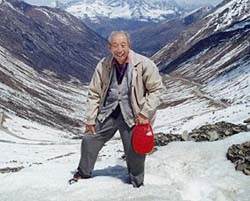
Prof. LIU Dongsheng, a researcher with the CAS Institute of Geology and Geophysics, has been awarded the Alexander von Humboldt Medal in 2007 by the European Geosciences Union (EGU) for his exceptional contributions to earth and environmental sciences, particularly in advancing the understanding of paleoclimatic change using Chinese loess-paleosoil sequence.
The Alexander von Humboldt Medal is reserved for scientists from developing countries (with emphasis on Latin America and Africa) who have achieved exceptional international standing in geosciences and planetary and space sciences, defined in their widest senses. Prof. Liu is the first Chinese winner of the prize.
Prof. Liu career has been highlighted with outstanding environmental achievements, particularly in advancing the understanding of paleoclimatic change and in promoting Chinese contributions to environmental science, according to the announcement of the EGU Jury.
By half a century of tireless and energetic endeavor, Liu established the Chinese loess-paleosoil sequence as a first-rank terrestrial record of paleoclimatic history for the past 2.5 million years, an achievement dreamed by a broad range of scientists for generations. It parallels the records of deep-sea sediments and polar ice sheets, and even combines the advantages of both records in completeness and high-resolution. This work was accomplished by convincingly demonstrating, from numerous publications, the following crucial points: (1) loess-paleosol sequence in China results from a continuous aeolian dust accumulation; (2) the accumulation rates closely relate to the atmospheric conditions, (3) the regional climate is linked to global climatic forcing; (4) the chronological framework of the entire loess sequence is possible; and (5) loess sequences allow the reconstruction of climatic variations at time scales going from the astronomical one of the glacial-interglacial cycles (as observed in deep-sea sediments) to the thousand years time scale. Liu has also greatly promoted and was -and still is- actively involved in recent studies that extend the lower boundary of Cenozoic eolian deposits in northern China, first to about 8 Ma BP based on the aeolian Red Clay, and then to about 22 Ma BP based on the Qinan eolian sequences, both being among the best Cenozoic climate records of the Euro-Asian continents.
Liu also extended and made tremendous contributions to applied environmental science. A geochemical approach conducted by Liu's team on the endemic disease, the Keshan Disease, led to a great advance in solving this half-a-century mystery. His finding of the relationship between loess collapse property and its composition proved effective in engineering prevention of water-soil erosion in the vast loess region.
Liu has proved to be extremely influential in both national and international geological and geo-environmental circles. He played a key role in the establishment of the most effective state laboratories and institutions for environmental research, and in the development of environmental science in China. He devoted full emotion and enthusiasm, promoted international cooperation and communication involving a broad range of scientists who have interest in some way in loess, and collaborated fruitfully with scholars worldwide. These efforts were extremely effective in boosting Chinese contributions to the advances of environmental science, and led to the blooming of Chinese loess research in international scientific forums over past decades.
Prof. Liu has demonstrated an impressive excellence both in scientific research and leadership, a combination rarely seen. Just because of such a combination maintained through his long lasting career, Liu has made an outstanding environmental achievement in the modern world.







